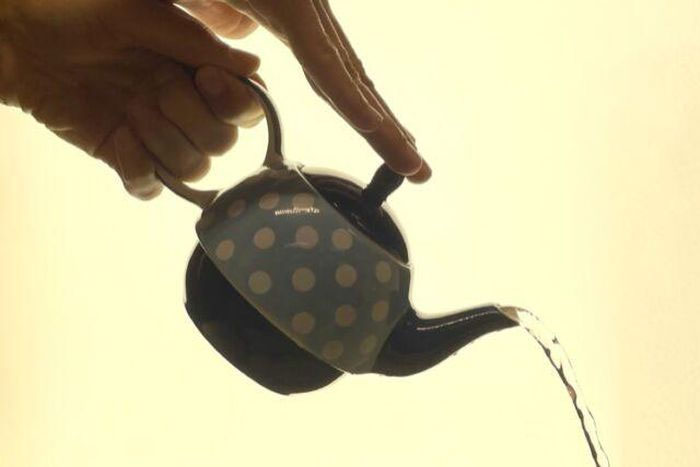The phenomenon of tea dripping and flowing down the teapot while pouring turns out to be more complex than you think.
The tea dripping phenomenon, known as the teapot effect , is a minor annoyance for regular tea drinkers. However, for physicists around the world, it has posed a theoretical problem that has lasted for decades. In fact, an Ig Nobel Prize was awarded to two scientists for calculating how to create a no-drip teapot spout.
In 2019, it seemed that the issue would be resolved when a group of Dutch physicists proposed a quantitative model to accurately predict the flow rate when tea is poured from a teapot. However, there is still much work to be done to fill in some gaps in the theory surrounding this particularly captivating physical phenomenon.
Recently, physicists at the Vienna University of Technology and University College London announced that they have finally developed a complete theoretical description of the teapot effect. It captures the intricate interplay of inertial forces, viscosity, and capillary action to redirect the flow of liquid under certain conditions. However, gravity has been shown to be less relevant to this phenomenon. This means that you would still observe the teapot effect on the Moon, according to the authors, but you would not see it if you poured tea on the International Space Station (ISS).
The researchers presented their theoretical calculations in a paper published in the September issue of the Journal of Fluid Mechanics. They have now also published the experimental results they conducted to test their theoretical model. If you’re still wondering what studying the process of pouring tea can do, know that the insights gained from this research could help us better control the flow of liquids in microfluidic devices, which is particularly important in medicine and biological research.

The teapot effect has puzzled physicists for decades.
Israeli engineer and scientist Markus Reiner first described the teapot effect in 1956 and was a pioneer in the field of rheology (the study of how fluids flow). Later, engineer and mathematician Joseph B. Keller conducted his own experiments and concluded that the dripping is caused by air pressure rather than surface tension, as many had assumed. He and a Belgian colleague, Jean-Marc Vanden‐Broeck, published a report in 1986, which earned them the Ig Nobel Prize in 1999. According to Keller, the pressure of the liquid while pouring is lower than the surrounding air, thus pushing the tea back into the spout and outside.
Specifically, at higher flow rates, the layer of liquid near the spout of the teapot separates to allow it to flow smoothly without dripping. However, at lower flow rates, when flow separation occurs, a layer clings to the surface of the teapot spout, leading to dripping. The diameter of the spout, the curvature of the spout’s tip, and the “wetting ability” (describing how a liquid adheres to the surface of a solid) of the material making the teapot are also factors that can influence whether dripping occurs.
However, they are not the main culprits. In 2010, French physicists demonstrated that the real cause is a type of “capillary effect” that prevents (at slower pouring rates) the liquid from separating from the spout for a smooth, clean flow. All other factors play a role in determining the strength of the capillary effect. These physicists suggested that making the tip of the spout thinner and sharper would reduce dripping, or even coating the spout with super water-repellent material.
Next, the 2019 study conducted by Etienne Jambon-Puillet, then a postdoctoral researcher at the University of Amsterdam, was inspired by how liquid wrapped around a cylindrical needle in a syringe he had to clean in the lab every day. Along with a few colleagues, he set up a series of vertical cylinders and shot dyed water jets into them, recording how the liquid behaved at different flow rates. They discovered that the water jets always traveled in a straight line at high flow rates, and when that rate decreased, the water began to deviate slightly. At even lower flow rates, the water began to curl and “stick” to the cylindrical surface before swirling around to form a spiral.
The researchers’ new model accurately predicted when the critical transition from “sticking” to – instead of separating from – a solid surface like a cylinder (or the spout of a teapot) would occur. They concluded that this happens when there is a combination of hydrostatic forces and wetting, linking the tea with the side of the teapot as it flows down.

The flow rate determines the size of those droplets.
And the latest report shows consistency with previous studies, asserting that reducing the critical flow rate will create the teapot effect. According to the authors, droplets will certainly form at the sharp edge beneath the spout, ensuring that this area remains wet. The flow rate determines the size of those droplets. At the lowest flow rates, the droplets can be large enough to redirect the entire flow around the edge, allowing the tea to flow down the body of the teapot.
As for the forces at play, inertia helps the liquid maintain its original direction. Capillary forces slow the flow rate at the spout. Other important factors include the contact angle between the liquid surface and the walls of the teapot and the wettability of the material making the teapot. The smaller the angle—or the more hydrophilic the material—the slower the liquid separates from the surface.
“Although this is a very common effect and seems simple, it is very difficult to explain it accurately within the framework of fluid mechanics,” said Bernhard Scheichl, a co-author of the study from the University of Vienna. “We have successfully provided a complete theoretical explanation for why this droplet forms and why the underside of the spout’s edge is always wet.”
Of course, the predictions of a well-functioning theory still need to be validated through experiments. Therefore, Scheichl and his colleagues tested their model by pouring water from a tilted teapot, varying the flow rates (high, medium, and very low) and capturing those dynamics with high-speed cameras. As seen in the GIF above, you can clearly see that reducing the flow rate below a critical point leads to the wetting of the spout and the characteristic dripping of water down the body, typical of the teapot effect.


















































